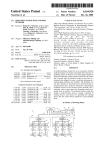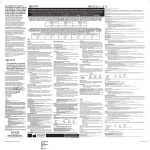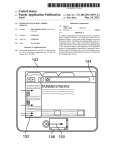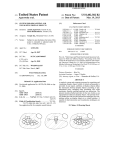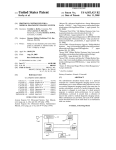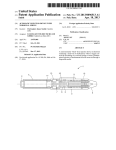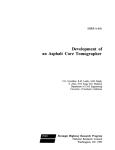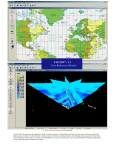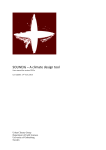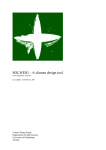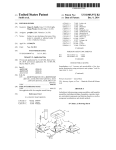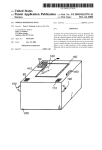Download Automatically supplying a pressurizing unit of a medical injection
Transcript
USOO8812082B2 (12) United States Patent (10) Patent N0.2 Hajicek et al. US 8,812,082 B2 (45) Date of Patent: (54) AUTOMATICALLY SUPPLYING A Aug. 19, 2014 20037060728814? 21* 2/2802 vovebllr uc 1 0n et a . .............. .. 604/151 PRESSURIZING UNIT OF A MEDICAL 2007/0100282 A1 * 5/2007 Small et al. INJECTION DEVICE WITH FLUID 2008/0161757 A1 * 7/2008 Nayak et a1. .................. .. 604/82 (75) Inventors: David Hajicek, Minnetonka, MN (US); 604/151 FOREIGN PATENT DOCUMENTS Richard Oftedahl, Jordan, MN (U S) (73) Assignee: ACIST Medical Systems, Inc., Eden P . . MN ralne, _ (*) S (U ) _ Notlce: _ _ _ EP 1 847 284 A1 10/2007 W0 01/74421 A1 10/2001 WO 2006/044409 A2 4/2006 wo wo 2007/033103 A1 3/2007 W0 W0 2007/062315 5/2007 Subject to any disclaimer, the term of this patent is extended or adjusted under 35 U'S'C' 15403) by 1413 days' A3 OTHER PUBLICATIONS Communication from European associate regarding responding to the communication dated Jun. 14, 2011, under Rules 161/162, ?led (21) (22) Appl' NO': 12/261’713 Filed Oct 30 2008 . . (65) , (Continued) Prior Publication Data Us 2010/0113924 A1 (51) with the European Patent Of?ce for European Patent Application No. 09744569.6-2319, dated Dec. 21, 2011, 20 pgs. P ' May 6, 2010 Int_ CL ' i T 5? Ch en (74) Attorney, Agent, or Firm * Shumaker & Sieffert, P.A. A61M 5/00 (2006.01) A61M1/00 (2006.01) (57) A61M 5/3 6 (2006.01) In general, this disclosure relates to techniques for automati (52) US, Cl, ABSTRACT cally supplying a pressuriZing unit (e.g., syringe) that is used CPC _ A61M 5/36 (2013.01); A61M 5/00 (201301); (58) E Hind” xaml'ier Asszstant Exammer * H1en Nguyen with a powered medical ?uid injection device with ?uid. An A61M1/00 (2013.01); A61M5/007 (2013.01) example method performed by the medical ?uid injection USPC ......................................... .. 600/432; 604/123 device includes obtaining operational state information of the Field of Classi?cation Search medical ?uid injection device, wherein the operational state CPC _________ __ A61M 5/36; A61M 5/00; A61M 1/()(); information includes information other than a ?uid delivery A61M 5/007 amount for a subsequent injection procedure. The example USPC ........................................................ .. 600/432 method fuITher includes 11$ng the Operational state informa See application ?le for complete search history tion to determine whether the powered medical ?uid injection device permits a ?uid replenishment operation for the pres suriZing unit. If the ?uid replenishment operation is permit ted, the method further includes automatically supplying the (56) References Cited U.S. PATENT DOCUMENTS 5,573,515 6,221,045 6,626,862 6,932,242 7,128,729 A B1 B1 B2 B2 11/1996 4/2001 9/2003 8/2005 10/2006 Wilson et a1. Duchon et al. Duchon et al. Gerlach et al. Duchon et a1. pressuriZing unit with an amount of medical ?uid. 1f the device includes multiple pressuriZing units, the device may initiate an automatic ?uid replenishment procedure for one or more of the pressuriZing units during operation. 30 Claims, 10 Drawing Sheets US 8,812,082 B2 Page 2 (56) References Cited First Of?ce Action (with English Translation) and Search Report for corresponding Chinese patent application No. 2009801446568, dated Nov. 2, 2012, 12 pages. OTHER PUBLICATIONS International Preliminary Report on Patentability for international application No. PCT/US2009/062384, dated Feb. 7, 2011, 11 pp. Of?ce Action from Australian Application No. 2009314380, dated May 10, 2012, 2 pp. Reply to Written Opinion, ?led With the IPENEPO in corresponding PCT Application No. PCT/US2009/062384, on Aug. 30, 2010 (11 Examination Report for corresponding Canadian patent application No. 2,741,702, dated Jan. 11, 2013, 2 pages. Of?ce Action from corresponding Korean Application No. 10-2011 7011092, With translation, dated Sep. 26, 2012, 7 pp. Examiner’s Opinion stated in the Of?ce Action for corresponding Japanese patent application No. 2011-534715, 1 page, Oct. 30, 2012. Response to Examiner’s Report dated May 10, 2012, for correspond ing Australian patent application No. 2009314380, dated May 30, pgS) 2013, 16 pages. Response to Examiner’ s Report dated Jan. 11, 2013, for correspond Noti?cation of Transmittal of the International Search Report and the Written Opinion of the International Searching Authority, or the Declaration from corresponding PCT Application No. PCT/US2009/ ing Canadian application No. 2,741,702, dated Jul. 11, 2013. Of?ce Action (with English Translation) for corresponding Korean patent application No. 10-2011-7011092, dated Mar. 26, 2013, 6 062384, mailed Mar. 19, 2010 (12 pages). pages. “ACIST CVi Contrast Delivery System User Manual”, ACIST Medi cal Systems, Inc., Nov. 2005, (91 pages). * cited by examiner US. Patent Aug. 19, 2014 Sheet 1 0110 US 8,812,082 B2 .102 1AFIG. US. Patent Aug. 19, 2014 Sheet 2 0f 10 US 8,812,082 B2 mv.OE US. Patent Aug. 19, 2014 Sheet 3 0110 US 8,812,082 B2 2AFIG. 206 US. Patent Aug. 19, 2014 Sheet 4 0f 10 US 8,812,082 B2 .GEmm New Pom US. Patent com Aug. 19, 2014 mum Sheet 5 0f 10 US 8,812,082 B2 o1N. " (mFwN ON.QE SN US. Patent Aug. 19, 2014 Sheet 6 0f 10 US 8,812,082 B2 mva .0EQN US. Patent Aug. 19, 2014 Sheet 7 0110 US 8,812,082 B2 306 304 3 FIG.3 US. Patent Aug. 19, 2014 Sheet 8 0110 US 8,812,082 B2 N O \ 406 400 f 416 418 408 FIG.4 US. Patent Aug. 19, 2014 Sheet 9 0f 10 US 8,812,082 B2 RECEIVE USER INPUT l—> OBTAIN OPERATIONAL STATE INFORMATION BY A PROCESSOR r 500 f“ 501 <— IF NECESSARY, TERMINATE CURRENT REPLENISHMENT OPERATION FOR PRESSURIZING UNIT 502 OES OPERATIONAL STATE INFORMATIO PERMIT REPLENISHMENT OF PRESSURIZING UNIT? USE STATE INFORMATION TO K. 504 DETERMINE FLUID REPLENISHMENT AMOUNT BY THE PROCESSOR SUPPLY PRESSURIZING UNIT WITH (- 506 DETERMINED FLUID AMOUNT ,- 508 INJECTOR OPERATIONAL STATE CHANGES FIG. 5 US 8,812,082 B2 1 2 AUTOMATICALLY SUPPLYING A PRESSURIZING UNIT OF A MEDICAL INJECTION DEVICE WITH FLUID powered medical ?uid injection device includes obtaining TECHNICAL FIELD information other than a ?uid delivery amount for a subse In one embodiment, an example method performed by a operational state information of the medical ?uid injection device, wherein the operational state information includes quent injection procedure. The example method further includes using the operational state information to determine whether the powered medical ?uid injection device will per mit a ?uid replenishment operation for a ?rst pressuriZing unit. If the ?uid replenishment operation is permitted, the method further includes automatically supplying the ?rst This disclosure generally relates to the use of pressuriZing units, such as syringes, within powered medical ?uid injec tion devices. BACKGROUND medical ?uid into a patient. These devices often include one pressuriZing unit with an amount of medical ?uid. In one embodiment, an example medical ?uid injection device includes a ?rst pressuriZing unit and an injector head or more reservoirs to hold the medical ?uid, and one or more that is con?gured to obtain operational state information of Medical ?uid injection devices are typically used to inject pressuriZing units to inject the medical ?uid into the patient. For example, a contrast media powered injection device may the device and use the operational state information to deter mine whether a ?uid replenishment operation is permitted for the ?rst pressuriZing unit, the operational state information include a reservoir containing contrast media and a syringe that is used to inject the contrast media into the patient. The contrast media injection device may be used during certain medical procedures, such as an angiographic or computed including information other than a ?uid delivery amount for a 20 tomography (CT) procedure. plies the ?rst pressuriZing unit with an amount of medical ?uid. Many medical ?uid injection devices include one or more syringes to inject ?uid. A syringe has a chamber for holding the ?uid and a plunger that is moveable within the chamber. The ?uid is typically drawn into the chamber from a ?uid reservoir when the plunger is moved in a ?rst direction. The subsequent injection procedure. If the ?uid replenishment operation is permitted, the medical ?uid injection device sup The details of one or more embodiments are set forth in the 25 accompanying drawings and the description below. Other features, objects, and advantages will be apparent from the description and drawings, and from the claims. ?uid is then expelled from the chamber and into the patient, BRIEF DESCRIPTION OF DRAWINGS via a catheter, when the plunger is moved in a second, oppo site direction. The ?uid is delivered at a rate that may be 30 determined by a speed of movement of the plunger. During a given medical procedure, a medical ?uid injec FIG. 1A is a perspective diagram of one embodiment of a powered medical ?uid injection device that may be used to automatically supply a pressuriZing unit with ?uid. tion device may need to deliver a determined amount of medical ?uid. If the pressuriZing unit, such as a syringe, does not contain a su?icient amount of ?uid for the procedure, a clinician may need to interact with the device to initiate a ?uid FIG. 1B is a perspective diagram of one embodiment of the 35 replenishment operation. For example, the clinician may push a button or otherwise interact with a graphical user interface (GUI) provided by the device to partially or com pletely ?ll the pressuriZing unit. In other cases, the device may be capable of calculating or otherwise determining an amount of ?uid remaining within the pressuriZing unit, and then supplying the pres suriZing unit with ?uid if it determines that this remaining amount is less than the amount that is required to perform an injection procedure for a patient. 40 45 powered medical ?uid injection device of FIG. 1A connected to various components, including ?uid reservoirs and tubing. FIGS. 2A-2D are various perspective diagrams of another embodiment of a powered medical ?uid injection device that may be used to automatically supply one or more pressuriZing units with ?uid. FIG. 3 is a perspective diagram of an example syringe that may be used with a powered medical ?uid injection device, according to one embodiment. FIG. 4 is a perspective diagram of a patient line that may be used with a powered medical ?uid injection device, according to one embodiment. SUMMARY FIG. 5 is a ?ow diagram of a method that may be performed by a powered medical ?uid injection device, according to one In general, this disclosure relates to techniques for auto matically supplying a pressuriZing unit (e.g., syringe) that is embodiment. 50 used with a medical ?uid injection device with medical ?uid. If the medical ?uid injection device includes multiple pres suriZing units, the device may initiate an automatic ?uid replenishment procedure for one or more of the pressuriZing units during operation, as will be described in more detail below. By automatically supplying a pressuriZing unit with ?uid at identi?ed times, the device is capable of preventing the pressuriZing unit from running empty during a medical procedure. The device may be capable of initiating a ?uid replenishment operation without having to know or calculate operation for one or more pressuriZing units. 55 DETAILED DESCRIPTION 60 powered medical ?uid injection device 100 that may be used to automatically supply a pressuriZing unit contained within a sleeve 108 with medical ?uid. In the embodiment of FIG. 1A, the pressuriZing unit within sleeve 108 is a syringe. In other embodiments, other forms of pressuriZing units may be used, FIG. 1A is a perspective diagram of one embodiment of a an amount of ?uid required for an injection procedure. As a result, a user of the device, such as a clinician, may not need to interact with the device to initiate a ?uid replenishment cycle. In addition, there may be fewer interruptions during a given medical procedure, and there may be opportunities to perform a greater number of procedures in a given time period due to higher operational ef?ciency of the device. FIG. 6 is a conceptual diagram illustrating various opera tional states during which time a powered medical ?uid inj ec tion device may initiate an automatic ?uid replenishment including other types of positive displacement pumps. Device 100 is, in some embodiments, used to inject medical ?uid, 65 such as contrast media or saline, into a patient during a medi cal procedure, such as an angiographic or computed tomog raphy (CT) procedure. Device 100 includes a control panel US 8,812,082 B2 3 4 102, an injector head 104, a sleeve 108 to hold a pressuriZing unit, a reservoir holder 110, a module 112, a patient manifold sensor 114, and an air detector 116. Injector head 104 valve may comprise a spring-biased spool valve, but in other embodiments, other types of valves, including check valves, may also be used. Patient manifold sensor 114 can detect the includes a pump 106 and also includes one or more processors manifold valve position and report this position to injector used to control and/ or monitor injector head 104, control head 104 for safety purposes. panel 102, the pressuriZing unit within sleeve 108, patient Device 100 also includes air detector 116. Tubing that runs from device 100 to an external catheter passes through air manifold sensor 114, and air detector 116 of device 100. Reservoir holder 110 is capable of holding a ?uid reservoir that contains an amount of ?uid to be drawn into the syringe detector 116, which is capable of detecting air bubbles or air columns within the tubing. If air detector 116 detects a mea sureable or otherwise signi?cant amount of air within the during operation of device 100. For example, reservoir holder 110 may hold a reservoir of contrast media or diluent. A tubing, it is capable of generating an alarm signal for injector second reservoir holder (not shown) may hold a diluent (e.g., head 104. In such a case, a warning or alarm message may be saline) for use in pump 106. FIG. 3 shows an example of a displayed to the operator on control panel 102, indicating that syringe that may be used within sleeve 108, according to one air has been detected. In addition, in one embodiment, device 100 may automatically pause, or terminate, a ?uid injection procedure if air detector 116 has detected air in the tubing, such that the air is not delivered to the catheter. Because device 100 may be used for many injections and embodiment. Patient manifold sensor 114 may, in some cases, be connected to a patient manifold, as will be described in reference to FIG. 1B. An operator of device 100, such as a clinician, may use control panel 102 to set up various parameters and/or proto cols to be used for a given injection procedure. For example, the operator may interact with control panel 102 to enter 20 holder 110 becomes empty, it may need to be manually replaced with a new (full) reservoir by the operator. In addi tion, the syringe in sleeve 108 may need to be supplied with injection ?uid from time to time, such that there is suf?cient injection parameters for ?ow rate, maximum injection vol ume, maximum injection pres sure, rise time, or other param eters. In one embodiment, control panel 102 includes a touch screen panel. 25 Pump 106 is capable of pumping ?uid. In one embodiment, pump 106 is a peristaltic pump. In this embodiment, tubing and a ?uid reservoir (not shown) are coupled to and through the syringe has decreased or is low, the operator may initiate a manual ?uid replenishment procedure by touching a button on or otherwise interacting with control panel 102. By doing 30 In addition, device 100 is capable of automatically supply 35 within the syringe is moved in a ?rst direction by the motor, ?uid is drawn from the reservoir into the syringe. The syringe within sleeve 108 is further coupled to output tubing. When the plunger within the syringe is moved in a second, opposite direction, ?uid is expelled out of the syringe into the output tubing. In one embodiment, the syringe is a dual-port syringe, such that the input tubing is coupled to one port of the syringe, 100 may determine this amount based upon volume informa tion input by the operatorusing control panel 102. Device 100 may further determine an amount of ?uid remaining in the 40 syringe, such as by making a calculation of remaining ?uid volume based upon amounts of ?uid injected from the syringe. If the amount remaining in the syringe is less than a maximum amount of ?uid to be delivered during an injection procedure, device 100 can cause inj ector head 104 to add ?uid 45 and the output tubing is coupled to another port of the syringe. FIG. 3 shows an example of such a dual-port syringe, which will be described in more detail below. Patient manifold sensor 114 is coupled to a manifold valve amount of medical ?uid. In one such situation, device 100 may determine a maximum amount of ?uid that is to be delivered during an injection procedure. For example, device 104. In one embodiment, injector head 104 includes a pro cessor that drives the motor assembly. In one embodiment, reservoir holder 110 holds a ?uid reservoir that is coupled to input ?uid tubing. This input ?uid tubing is coupled to the syringe, such that when the plunger so, the operator may manually supply the syringe with ?uid contained in the reservoir, either partially or completely. ing the syringe, in certain situations, with a determined a catheter. Pump 106 is driven by a motor that is part of pump 106, and the plunger within the syringe is driven by a motor assembly, including an actuator, that is part of injector head ?uid within the syringe to perform injections for patient pro cedures. When an operator detects that a ?uid volume within pump 106. Pump 106 pumps ?uid from the ?uid reservoir through the tubing towards module 112. In the example of FIG. 1A, both pump 106 and the syringe contained within sleeve 108 are capable of delivering ?uid from device 100 into patient procedures, injection ?uids may need to be continu ously replaced. For example, when the reservoir held by 50 to the syringe. In one embodiment, injector head 104 of device 100 uti lizes operational state information for device 100 in deter mining whether or not a ?uid replenishment operation is permitted for the syringe in sleeve 108. This operational state information may comprise many different types of state infor mation, but may include information other than an amount or (not shown), according to one embodiment. This manifold valve controls ?ow of ?uid from tubing coupled to either the volume of ?uid that is to be delivered from the syringe for a syringe in sleeve 108 or pump 106. In one embodiment, the device 100 need not necessarily know how much ?uid may need to be delivered from the syringe during an injection manifold valve is coupled to output tubing from the syringe subsequent injection procedure. That is, injector head 104 of 55 and also to tubing that runs through pump 106. Tubing also is coupled between the manifold valve and air detector 116. procedure in order to determine whether or not to initiate a After passing through air detector 116, the tubing is then utilize other operational state information in order to make ?uid replenishment operation. Instead, injector head 104 may coupled to a patient line or catheter (not shown), such that ?uid can ultimately be delivered from device 100 to a patient. The manifold valve held by the patient manifold sensor 1 14 such a determination. 60 is capable of controlling the ?ow of ?uid from the syringe and operational state information may include, but are not limited to, information related to any combination of the following pump 106 to an external catheter. In one embodiment, the manifold valve has a ?rst position that allows only ?uid from the syringe to be delivered to the catheter. The manifold valve has a second position that allows only ?uid from pump 106 to be delivered to the catheter. In one embodiment, the manifold Operational state information may include information describing operating states or conditions of various portions of a ?uid injection device, such as device 100. Examples of 65 operational states: (I) currently delivering/inj ecting ?uid from a pressuriZing unit (e.g., “injecting”) (yes/no); (2) cur rently delivering ?uid from a pump (yes/no); (3) armed (yes/ US 8,812,082 B2 6 5 no); (4) setup complete (yes/no); (5) air present (yes/no); (6) FIG. 1B is a perspective diagram of one embodiment of the powered medical ?uid injection device 100 of FIG. 1A con valve position (e.g., spool valve) set to a speci?ed position nected to various components, including ?uid reservoirs and tubing. For example, FIG. 1B shows a ?rst ?uid reservoir 132 (positional value); (7) pressuriZing unit/syringe full; and (8) auto ?uid supply mode (on/off). As these examples illustrate, and a second ?uid reservoir 138. First ?uid reservoir 132 contains a ?rst ?uid, such as contrast media. An operator may hang ?rst ?uid reservoir 132 on reservoir holder 110. In some operating state information may, in some cases, have a ?nite, relatively small number of values associated with certain states. For example, the state of “currently delivering/inject ing ?uid from the pressuriZing unit” can only have a value of cases, ?rst ?uid reservoir 132 may be a glass reservoir, while in other cases, it may be a plastic reservoir. The ?uid con Yes or No. It is possible that some types of operational state tained within ?rst ?uid reservoir 132 may be drawn through tubing and into a pressuriZing unit 130 (e.g., a syringe) that has been inserted into sleeve 108 during operation. During an automatic replenishment operation, device 100 may auto matically supply pressuriZing unit 130 with an amount of ?uid from ?rst ?uid reservoir 132. information can have more than 2 values for a given opera tional state. For example, a three-position switch may have any of three different state values, and a valve having more than two possible positions may also have multiple different state values (depending on the position of the valve). The operational state information could thus be used to de?ne a Second ?uid reservoir 138 may contain a second ?uid, such as saline. An operator may hang second ?uid reservoir 138 on logic table (e.g., a set of rules) that determines, for a given combination of operating states or conditions, whether a ?uid a hook 137. In some cases, second ?uid reservoir 138 may be replenishment operation is permitted, and may also automati cally initiate such a replenishment operation. Each pressur iZing unit (e.g., syringe, pump) that is used within the device a plastic reservoir, such as a bag. The ?uid contained within 20 FIG. 1B also shows that a hand-control device 136 is coupled to control panel 102 via a connector 134. In one embodiment, hand-control device 136 may be connected to may have its own associated operational state information. For example, if injector head 104 uses operational state information to determine that device 100 is currently deliv ering ?uid from pump 106 but not from the syringe contained in sleeve 108, injector head 104 may use this state information to determine that it is permitted to automatically supply the syringe with medical ?uid, if necessary (provided that the auto ?uid supply mode parameter is set to “on”). That is, if the syringe is not currently delivering ?uid, injector head 104 25 30 is currently full, injector head 104, of course, would not need to initiate a ?uid replenishment procedure. But, if the syringe 35 determined amount of ?uid. In one scenario, injector head 40 In one embodiment, a known or determined amount of ?uid may be supplied to the syringe during a replenishment operation. In one embodiment, device 100 may cause replen ishment of the syringe when the amount remaining in the syringe is below the maximum amount of ?uid to be delivered during an injection procedure by a threshold amount (e. g., to limit excessive ?uid replenishment operations). In one embodiment, replenishing of the syringe with ?uid may occur when the amount of ?uid remaining in the syringe is less than a certain level (or less than a speci?ed amount of remaining 45 device to variably control the rate of ?ow of ?uid from device 100 (e.g., ?ow of ?uid out of pressuriZing unit 130). In one embodiment, hand-control device 136 may comprise an elec trical device. In one embodiment, hand-control device 136 may comprise a pneumatic device. Tubing 128 is coupled to a pressure transducer 126. Pres sure transducer 126 is also coupled to output, high-pressure tubing 122, which may be connected to a patient line via connector 120. When high-pressure tubing 122 is connected to a patient line (within a patient), pressure transducer 126 is capable of functioning as a hemodynamic monitor for the patient. Pressure transducer 126 converts detected pressures into electrical signals that may be monitored or otherwise used by device 100 or another monitoring device. High-pres sure tubing 122 also runs through air detector 116. Air detec tor 116 is capable of detecting the presence of air (e.g., air bubbles or columns) within ?uid that may be ?owing through 50 high-pressure tubing 122. FIG. 1B also shows a manifold valve 124. This manifold valve 124 is connected to high-pressure tubing 122, as well as patient manifold sensor 114. Manifold valve 124 is capable of controlling a ?ow of ?uid from pressuriZing unit 130 and/or ?uid), e.g., when the amount remaining in the syringe is less than a determined percentage of the capacity of the syringe, or less than a determined percentage of the maximum amount. User-selectable parameters may be used to specify threshold operator may manipulate hand-control device 136 to control injection of ?uid from device 100. For example, the operator may use hand-control device 136 as a variable-rate control is not full, injector head 104 may actuate a motor/actuator 104 may decide to completely ?ll the syringe to capacity. Thus, if the syringe is a 100 milliliter (ml) syringe and is currently half full of medical ?uid, injector head 104 may ?ll syringe to a full 100 ml capacity. In one scenario, injector head 104 may only partially ?ll the syringe with ?uid. another component of device 100 other than control panel 102.As shown in FIG. 1B, hand-control device 136 is coupled to tubing, cabling, or wiring, which connects hand-control device 136 to connector 134. Connector 134 may then be connected to or disconnected from control panel 102. An may cause the syringe to be supplied with ?uid. If the syringe assembly coupled to the syringe to supply the syringe with a second ?uid reservoir 138 may be drawn through tubing 128 through operation of pump 106. 55 through pump 106 to high-pressure tubing 122. For example, amounts or determined percentages. in one embodiment, when manifold valve 124 is in a ?rst In one embodiment, device 100 may dynamically termi nate a ?uid replenishment procedure of the syringe if the operational state of device 100 changes such that a replenish 60 position, ?uid may ?ow from pressuriZing unit 130 to high pressure tubing 122. When manifold valve 124, however, is in a second position, ?uid may ?ow through pump 106, via tubing 128, to high-pressure tubing 122. In one embodiment, ment operation is no longerpermitted. For example, if, during manifold valve 124 may allow ?uid ?ow to high-pressure tubing 122 from only one of pressuriZing unit 130 or pump a ?uid replenishment cycle, the operator wishes to initiate an injection of ?uid from the syringe, injector head 104 may terminate the ?uid replenishment cycle and begin an injection procedure for injection of ?uid from the syringe. Additional examples and embodiments pertaining to automated ?uid replenishment operations will be further described in more detail below. 106 at a time. 65 FIG. 2A is a perspective diagram of another embodiment of a powered injection device 200 that may be used to perform various functions and, when operable, may initiate an auto mated ?uid replenishment operation. In FIG. 2A, device 200 US 8,8l2,082 B2 7 8 includes a ?rst primary reservoir holder 202A, a second pri mary reservoir holder 202B, an electrical connection inter face 206, a ?rst backup reservoir holder 208A, a second backup reservoir holder 208B, a control panel 212, a ?rst syringe sleeve 216A, a second syringe sleeve 216B, a ?rst devices separate from device 200. In one embodiment, the larger control panel looks similar to control panel 102 shown in FIG. 1A. Device 200 is a dual-syringe device that includes two syringes contained within sleeves 216A and 216B. Both syringes are capable of delivering medical ?uid to a patient. In one embodiment, the syringe within sleeve 216A is capable of drawing in ?uid from a ?uid reservoir coupled to holder 202A, and the syringe within sleeve 216B is capable of drawing in ?uid from a ?uid reservoir coupled to holder 202B. For example, these syringes may draw in ?uid during a ?uid replenishment operation. Each syringe is coupled to a motor/ actuator assembly (not shown) that drives a plunger in one of two directions. During a ?uid replenishment cycle, for example, a motor/ actuator assembly of device 200 may drive front-end assembly 218A, a second front-end assembly 218B, and a patient connection guide rod 220. In the embodi ment of FIG. 2A, the pres suriZing units that are used to deliver medical ?uid are syringes that are contained within sleeves 216A and 216B. Injector head 201 includes reservoir holder 202A, reservoir holder 202B, connection interface 206, res ervoir holder 208A, reservoir holder 208B, and control panel 212. Injector head 201 further includes one or more proces sors used to control and/ or monitor the components of inj ec tor head 201 and other components of device 200. Reservoir holder 202A is capable of holding a ?rst reser a plunger within the syringe in sleeve 216A in one direction to draw ?uid from a reservoir coupled to holder 202A into the voir of medical ?uid, while reservoir holder 202B is capable of holding a second reservoir of medical ?uid. In one embodi ment, reservoir holder 202A holds a reservoir of a ?rst type of ?uid, such as contrast media, while reservoir holder 202B holds a reservoir of a second, different type of ?uid, such as a 20 device 200 contains two distinct motor/actuator assemblies, such that one assembly drives the syringe within sleeve 216A while another drives the syringe within sleeve 216B. These motor/ actuator assemblies are part of injector head 201, and diluent (e.g., saline). Different forms of reservoirs (e.g., bottles, bags) may be used with reservoir holders 202A and 202B. Because device 200 may be used to inject medical ?uid over multiple patient procedures, the reservoirs held by hold 25 ers 202A and 202B may need to be replaced over time. Typi 216A and 216B to the ?uid reservoirs and to output lines, according to one embodiment. In one embodiment, the device 200 additionally includes backup holders 208A and 30 202A or 202B runs empty and needs to be replaced, operator may quickly and easily access a new ?uid reservoir from one of backup holders 208A or 208B and attach to primary holder 202A or 202B. 200 to such an imaging device. In one embodiment, device 200 may transmit injection and/or control information to an external imaging device via interface 206, and may receive imaging and/or control information from the external imag ing device via interface 206, as well. FIG. 2A shows that device 200 also includes control panel 212. Control panel 212 is located on the top side of example device 200. The operator may interact with control panel 212 to program various injection procedure parameters and/or protocols that may be used for injection procedures. The Front-end assembly 218A is associated with sleeve 216A, and front-end assembly 218B is associated with sleeve 216B. 40 45 contents of the assembly 218A or 218B even when the door is 50 218B includes air detectors and valve components (not shown). Air detectors are used to detect air bubbles or air columns within the ?uid tubing that is used. The valve com ponents are used to allow or restrict ?uid ?ow through tubing. For example, when pinch valves are used, the valves pinch 55 ume, pressure, rise time, procedure type, ?uid information, 60 activated screen. ?uid tubing to restrict ?uid ?ow in one state, but stay open to allow ?uid ?ow in another state. Various different forms of valves may be used within assemblies 218A and 218B. In addition, various different forms of air detectors (e.g., ultra sonic, optical) may be used, as well. In one embodiment, the input and output tubing that is coupled to the syringe in sleeve 216A runs through front-end assembly 218A, and the input and output tubing that is In one embodiment, a separate, larger control panel (not shown) may also be in communication with device 200. In this embodiment, the larger control panel provides similar operator functionality to that provided by control panel 212. embodiment, each door may be made of a transparent or translucent material, such that the operator may see inside the closed. In one embodiment, each front-end assembly 218A and various injection-related information (such as ?ow rate, vol and/ or patient information). FIG. 2A shows various user activated buttons on the side of control panel 212. However, in one embodiment, control panel 212 may include a touch Output tubing from the syringe in sleeve 216A runs through assembly 218A and out to a patient line, while output tubing from the syringe in sleeve 216B runs through assembly 218B and out to the patient line. Each assembly 218A and 218B includes a door, or cover, which may be opened and closed by the operator. For the example, the operator may open the door when loading tubing and may be closed upon loading. In one operator may also use control panel to set up device 200 for use, to begin, pause, resume, or end a procedure, or to view syringes each are dual-port syringes (such as the dual-port syringe shown in FIG. 3). In this embodiment, one syringe port is used for input tubing that is coupled to a ?uid reservoir, while the second port is used for output tubing that is opera tively coupled to an output (patient) line through assemblies 35 218A or 218B. Device 200 includes electrical connection interface 206 to directly or indirectly couple device 200 to an external medical device, such as a medical imaging device. Typically, device 200, when used as a contrast media injection device, works in conjunction with a medical imaging device. For example, device 200 may work in conjunction with a medical imaging device during an angiographic or CT procedure. Connection interface 206 is used to directly or indirectly connect device may individually be controlled or monitored by the one or more processors included within injector head 201. Fluid input tubing couples the syringes within sleeves cally, an operator of device 200 manually replaces the reser voirs on holders 202A and 202B. For operator convenience, 208B. The operator may store backup ?uid reservoirs on holders 208A and 208B. When a reservoir on primary holder syringe. During an injection cycle, the motor/ actuator assem bly of device 200 may drive the plunger within this syringe in the opposite direction to expel ?uid. In one embodiment, coupled to the syringe in sleeve 216B runs through front-end assembly 218B. In this embodiment, each assembly 218A 65 and 218B contains a ?rst pinch valve and a ?rst air detector However, the larger control panel may be mounted to a rail of coupled to the input tubing for the respective syringe, and a bed on which a patient is lying, or may be mounted to other further contains a second pinch valve and a second air detec US 8,812,082 B2 10 tor coupled to the output tubing for the respective syringe. a button or actuates a component, the greater the ?ow rate of These components are more clearly shown in FIG. 2D and will be discussed in more detail below. injected ?uid from the syringe in sleeve 216A or 216B. FIG. 2C is another perspective diagram of device 200. FIG. 2C shows a top view of device 200, according to one embodi FIG. 2A also shows a patient connection guide rod 220. The output tubing from syringes 216A and 216B run through front-end assemblies 218A and 218B, respectively, and are then coupled to a patient line, or kit (not shown). The patient line is a single-use line, according to one embodiment, that is used for a single patient procedure. Each patient line may be ment. FIG. 2C also shows doors 221A and 221B on front-end assemblies 218A and 218B, respectively. As noted above, in one embodiment, each of assemblies 218A and 218B include a moveable door 221A and 221B, respectively. Door 221A covers assembly 218A, and door 221B covers assembly 218B. In the embodiment of FIG. 2C, doors 221A and 221B are made of a transparent, or semi-transparent, material, such that an operator may see the contents of assemblies 218A and 218B (which are shown in more detail in FIG. 2D). Door 221A includes a handle 219A, and door 221B includes a handle 219B. The operator may utilize handles 219A and 219B to open and close doors 221A and 221B, respectively. connected to and disconnected from the output tubing run ning through front-end assemblies 218A and 218B. The patient line is connected to the output tubing via connection guide rod 220, according to one embodiment. The patient line may slide over connection guide rod 220 in order to become coupled with the output tubing. In one embodiment, the patient line includes two tubing elements, each element cor responding to one of the output tubing elements of the syringe in sleeve 216A or 216B. An example patient line is shown in FIG. 4 and will be discussed in more detail below. In one embodiment, a medical ?uid injection device, such Doors 221A and 221B are coupled to one or more hinges 228, 20 inserted through hinges 228, according to one embodiment, as device 200, may include a plurality of pressuriZing units, including three or more pressuriZing units. Each of these pressuriZing units may be included within a separate sleeve during operation. In some cases, multiple pressuriZing units may contain the same type of ?uid. For example, a ?rst pressuriZing unit may contain contrast media, a second pres suriZing unit may contain a diluent (e.g., saline), and a third pressuriZing unit may contain contrast media. In this sce nario, the third pressuriZing unit may comprise a backup, or secondary, source of contrast media. In this example, the ?rst 25 30 and third pressuriZing units may both be coupled to a common front-end assembly, such as a front-end assembly similar to operator may choose to remove doors 221A and 221B if the 35 with front-end assemblies 218A and 218B, can be more clearly seen. Although the doors of assemblies 218A and 218B are closed in the example of FIG. 2B, they are made of a semi -transparent material, such that the interior pinch valve and air detector components may be more clearly seen. FIG. 2B also shows connection ports 222 and 224. In one embodi ment, a pressure transducer connector (such as one coupled to connector 410 shown in FIG. 4), may be connected to con nection port 224. The pressure transducer connector is opera tively coupled to a pressure transducer, which measures 40 and a second air detector 236A. Input tubing from a reservoir on holder 202A runs through air detector 230A and pinch valve 232A and into a syringe in sleeve 216A via a ?rst 45 syringe port, according to one embodiment. Output tubing coupled to a second syringe port of the syringe in sleeve 216A runs through pinch valve 234A and air detector 236A and is ing a pressure transducer to connection port 224, device 200 is capable of utiliZing and processing hemodynamic pressure tion of one or both of syringes in sleeves 216A and 216B. For example, the operator may push a button or otherwise interact 218A and 218B shown in more detail, according to one embodiment. Although doors 221A and 221B are not shown in FIG. 2D, they are made of a transparent, or semi-transpar ent, material, such that the contents of assemblies 218A and 218B may be more clearly seen by an operator, even when doors 221A and 221B are closed. Front-end assembly 218A includes a ?rst air detector 230A, a ?rst pinch valve 232A, a second pinch valve 234A, patient hemodynamic signals on the patient line. By connect signals of a patient that are detected in the patient line. Device 200 also includes connection port 222, which may be connected to a hand-control device (not shown). In one embodiment, the hand-control device is a disposable compo nent that may be used by the operator for a single patient procedure. The hand-control device may control the opera to securely allow doors 221A and 221B to be freely opened and closed by an operator. Doors 221A and 221B pivot about an axis that runs through pivot pin 229. In one embodiment, pivot pin 229 is screwed into place. Pivot pin 229 may also be removed by an operator. For example, the operator may unscrew pivot pin 229 and remove it from front-end assemblies 218A and 218B. After pivot pin 229 has been removed, doors 221A and 221B may also be removed from assemblies 218A and 218B. For example, the operator wishes to clean or replace doors 221A and 221B. FIG. 2D is a perspective view of front-end assemblies 218A or 218B. FIG. 2B is another perspective diagram of device 200 shown in FIG. 2A. In FIG. 2B, sleeves 216A and 216B, along which allow doors 221A and 221B to be opened and closed. Also shown in FIG. 2C is a pivot pin 229. Pivot pin 229 is 50 then coupled an external patient line, or kit (such as the one shown in FIG. 4). Air detector 230A is used to detect air bubbles or columns within the input tubing, and air detector 236A is used to detect air bubbles or columns within the output tubing. Air detectors 230A and 236A may comprise acoustic-based, optical-based, or other forms of air detectors. If either or both of air detectors 230A and 236A detect a 55 measurable amount of air in the input and/or output tubing, these detectors may propagate signals to injector head 201 of with the hand-control device to cause a motor/ actuator assem device 200. One or more processors of inj ector head 201 may bly to inject ?uid from the syringe in sleeve 216A, and may process these received signals. Injector head 201 may provide push another button or otherwise interact with the hand control device to cause a motor/actuator assembly to inject a warning message or alert to the operator via control panel 60 212, such that the operator may take appropriate action. Inj ec tor head 201 may also, in one embodiment, automatically pause or terminate any injection of ?uid from the syringe in sleeve 216A if air has been detected in the input and/ or output tubing, by controlling operation of the motor/ actuator assem 65 bly driving the syringe. ?uid from the syringe in sleeve 216B. Thus, if the syringe in sleeve 216A contains contrast media, and the syringe in sleeve 216B contains a diluent, the operator may push one button on the hand-control device to inject contrast into the patient line, and may push another button to inject saline. In one embodiment, the hand-control device contains variable rate functionality, such that the harder the operator pushes on Pinch valve 232A controls a ?ow of ?uid from input tubing into the syringe in sleeve 216A. Injector head 201 controls the US 8,812,082 B2 11 12 For example, injector head 201 may obtain operational operation of pinch valve 232A. When injector head 201 opens state information at a given point in time to determine that pinch valve 232A, ?uid may ?ow from the reservoir con nected to holder 202A and into the syringe. When pinch valve 232A is closed, no ?uid ?ow is permitted within the input device 200 is injecting ?uid from the syringe in sleeve 216A, but is not injecting ?uid from the syringe in sleeve 216B. Given this operational state information, injector head 201 tubing. For example, when injector head 201 is supplying the syringe with ?uid, it may open pinch valve 232A to allow ?uid ?ow in the input tubing, but it may also close pinch valve 234A, to prohibit any ?uid ?ow in the output tubing. The plunger within the syringe may be moved in a ?rst direction (by the motor/actuator assembly) to supply ?uid to the syringe. When a ?uid injection occurs, the motor/actuator may then be able to determine that it can supply the syringe in assembly will move the plunger within the syringe in a sec 201 need not initiate a ?uid replenishment operation, since it determines that a supply amount would essentially be equal to zero. If, however, the syringe is not full to capacity, injector head 201 may supply the syringe in sleeve 216B with a determined amount of ?uid. For example, injector head 201 may cause the syringe to be completely ?lled to capacity. Or, injector head 201 may otherwise use operational state infor sleeve 216B with ?uid, if necessary, given that this syringe is not currently being used to inject ?uid. Injector head 201 may ?rst check to see if this syringe is already full, such as by checking additional operational state information or by mak ing a calculation. If the syringe is already full, injector head ond, opposite direction. Injector head 201 may close pinch valve 232A during an injection procedure, to prohibit ?uid ?ow in the input tubing. However, injector head 201 may open pinch valve 234A, to allow ?uid ?ow in the output tubing during such a procedure. In such fashion, injector head 201 utilizes pinch valves 232A and 234A to control ?uid ?ow in the input and output tubing during various operations (e.g., replenishment and injection operations). mation to determine an amount of ?uid to use during the ?uid 20 Injector head 201 may determine whether the syringe in sleeve 216B is already full using a number of different In one embodiment, pinch valves 232A and 234A are sole noid-based pinch valves. In other embodiments, other forms of pinch valves 232A and 234A may be used, such as pneu matic-based valves. In one embodiment, pinch valves 232A and 234A have default states in the closed position. Thus, when device 200 is neither supplying ?uid into nor injecting replenishment operation. approaches. For example, in one scenario, injector head 201 may use operational state information to determine how much 25 ?uid remains in the syringe. In another scenario, injector head ?uid from the syringe in sleeve 216A, both pinch valves 232A 201 may calculate an amount of remaining ?uid based upon an amount of ?uid that has been injected from the syringe in and 234A are closed. Pinch valves 232A and 234A may then prior injection procedures, which may also be obtained from be opened by device 200 when energy is actively applied to pinch valves 232A and/or 234A. When no energy is applied to pinch valves 232A and/ or 234A, they return to a default, closed position. Thus, if there are any power failures to device 200, valves 232A and 234A will return to closed position. operational state information of device 200. Operational state 30 device 200, including operational information, injection parameters used, error messages, alert conditions, and any other related information. Using another example, injector head 201 may also gather This may help improve the safety of device 200. Similarly, front-end assembly 218B includes a ?rst air detector 230B, a ?rst pinch valve 232B, a second pinch valve 234B, and a second air detector 236B. Input tubing from a 35 40 syringe port of the syringe runs through pinch valve 234B and 45 of initiating ?uid replenishment cycles for the syringes in tion for one or both of the syringes. If a ?uid replenishment in sleeve 216A with ?uid, but detects that the operator now wants to initiate an injection procedure using ?uid from this 50 its processors to perform certain operations. 55 example, when a syringe delivers ?uid to a catheter in a patient, a clinician may inject intermittent, frequent “puffs” of 60 to know an amount of ?uid that is to be injected from the syringe in sleeve 216A or 216B for a patient injection proce with ?uid. contrast media from device 200 during placement of the catheter within the patient. In this example, it may sometimes be bene?cial to avoid, or prohibit, replenishment operations in between these “puff” injections. Thus, a ?uid replenish ment operation may, in some cases, only be permitted if a dure in order to determine whether or not to allow and initiate effective and ef?cient way by which to supply the syringes In one embodiment, a ?uid replenishment operation may be permitted if at least a determined amount of time has elapsed since a prior injection of medical ?uid from one of the pressuriZing units (e. g., syringes) in sleeve 216A or 216B. For embodiment, such that device 200 need not necessarily need a ?uid replenishment operation. This may provide a more syringe, injector head 201 will stop the ?uid replenishment operation and initiate an injection operation. During any of these operations, injector head 201 may utilize one or more of operation is permitted for one of these syringes, injector head 201 then initiates a ?uid replenishment operation with a deter mined amount of medical ?uid. The operational state infor mation includes information other than a ?uid delivery vol ume for a subsequent injection procedure, according to one 216A or 216B with ?uid, it continually monitors the state of device 200, according to one embodiment. If the state of device 200 changes, injector head 201 may pause or abort a ?uid replenishment operation that is taking place. For example, if device 200 is automatically supplying the syringe In one embodiment, device 200 of FIGS. 2A-2D is capable sleeves 216A and/ or 216B during different operational states of device 200. In this embodiment, injector head 201 may obtain operational state information for the device, such as, for example, the type of operational state information described with reference to FIGS. 1A-1B. Injector head 201 then is capable of using the operational state information to determine whether it will permit a ?uid replenishment opera more subsequent procedures to be performed. In this case, injector head 201 may initiate a ?uid replenishment operation for both of the syringes. When injector head 201 is supplying the syringe in sleeve air detector 236B, and may then be coupled to a patient line. The components within device 218B function similarly to those contained within device 218A as described above, according to one embodiment. operational state information indicating that neither of the syringes in sleeves 216A or 216B is being used to inject ?uid at a given time. This may be the case when an operator is using control panel 212 to set up injection parameters for one or reservoir connected to holder 202B runs through air detector 230B and pinch valve 232B and into a ?rst syringe port of the syringe in sleeve 216B. Output tubing coupled to a second information includes current and past state information about 65 determined amount of time (e.g., 30 seconds) has elapsed since a prior injection, or “puff,” of contrast media. In some cases, a ?uid replenishment operation may be permitted if a US 8,812,082 B2 13 14 ?uid volume in the syringe has decreased at least a deter mined amount since a prior replenishment operation was a connector 310, which may be connected to a ?uid reservoir performed. 216A. For example, if connector 310 is a spike, the spike may in holder 202A, assuming syringe 301 is loaded into sleeve Table 1 below shows examples of a number of different be inserted into a bottle of medical ?uid connected to holder states of operation of device 200 during which one or more 202A. Output tubing 304 is coupled to a connector 306, which couples output tubing 304 to a separate patient line. In one ?uid replenishment operations of the syringes in sleeves 216A and 216B may be initiated. From the examples shown in Table 1, it is assumed that the syringe in sleeve 216A is used for injecting contrast media and that the syringe in sleeve 216B is used for injecting saline, which is a diluent. Addi tional states and/or operations to those listed may also be may run through air detector 230A and pinch valve 232A possible. (FIG. 2D) of front-end assembly 218A, which was described embodiment, connector 306 is a Luer-type connector. Fluid is drawn from the ?uid reservoir into port 300 of syringe 301 via input tubing 308. Fluid is expelled from port 302 of syringe 301 into output tubing 304. Input tubing 308 TABLE 1 STATE OF INJECTION DEVICE 200 Contrast media purge from syringe in sleeve FLUID REPLENISHMENT OPERATION Supply saline to syringe in sleeve 216B 216A Saline purge from syringe in sleeve 216B Supply contrast media to syringe in sleeve 216A Contrast media injection from syringe in Supply saline to syringe in sleeve 216B sleeve 216A Saline injection (or KVO cycle) from syringe Supply contrast media to syringe in sleeve in sleeve 216B 216A Injection parameter entry/change by operator Supply contrast media to syringe in sleeve on control panel 212 216A and/or supply saline to syringe in sleeve 216B Standby mode for device 200 Supply contrast media to syringe in sleeve 216A and/or supply saline to syringe in sleeve 216B Contrast media reservoir change by operator Supply saline to syringe in sleeve 216B (such as by replacing reservoir on holder 202A) Saline reservoir change by operator (such as by replacing reservoir on holder 202B) Supply contrast media to syringe in sleeve 216A In the examples of Table 1, purge operations from the 35 syringes in sleeves 216A and/or 216B occur when device 200 in more detail above, while output tubing 304 may run through pinch valve 234A and air detector 236A. In one is being primed, or prepared, for patient use. Thus, during embodiment, syringe 301, along with input tubing 308, con purge operations, device 200 is not yet connected to a patient. nector 310, output tubing 304, and connector 306, are dispos able, multi-use components. That is, these components may Conversely, during injection operations from the syringes, ?uids are injected into a patient. Device 200 may also be used 40 for KVO, or “keep vessel open”, operations. A KVO opera be used within device 200 over multiple uses or patient pro cedures before they are disconnected from device 200 and tion occurs when small amounts of diluent are repeatedly or disposed of. In another embodiment, these components are continuously injected. Also in reference to Table 1, device 200 may be in standby mode when neither syringe is being used to inject ?uid. For example, device 200 may enter disposable, single-use components, meaning that they are disposed of after a single patient procedure. 45 In one embodiment, syringe 301 may also be used in device 100 (FIG. 1A). When used in device 100, connector 310 standby mode after a patient case has been ?nished, and before the operator has entered parameters or otherwise con ?gured the device using panel 212 for a new case. In one embodiment, the examples shown in Table 1 are based upon would be connected to a ?uid reservoir on holder 110, and output tubing 304 would run through patient manifold sensor 50 an assumption that only one of the contrast media or diluent is injected at a time. In some cases, during an automatic ?uid replenishment operation, a user or operator may intervene by interacting with the control panel, such as control panel 102 (FIG. 1A) or control panel 212. For instance, an operator may choose to 55 connector 404. When assembly 401 is coupled to device 200, 60 ment. Syringe 301 may be loaded in either sleeve 216A or 216B. If syringe 301 is loaded into sleeve 216A, it may be coupled to a ?uid reservoir connected to holder 202A (FIG. 2A), and may further be coupled to a patient line (FIG. 4). Syringe 301 is a dual-port syringe in the example of FIG. 3. Input port 300 is coupled to input tubing 308, and output port 302 is coupled to output tubing 304. Input tubing is coupled to may be used with injection device 200 shown in FIGS. 2A-2C, according to one embodiment. Patient line 400 includes an assembly 401, a valve 416, a stopcock 418, and a connector 420. Patient line 400 is used to couple device 200 with a catheter that is used to deliver medical ?uid to a patient. Assembly 401 includes a ?rst connector 402 and a second terminate a ?uid replenishment operation, or may choose to modify one or more ?uid supply parameters. FIG. 3 is a perspective diagram of an example syringe 301 that may be used within device 200, according to one embodi 114. FIG. 4 is a perspective diagram of a patient line 400 that connector 402 is connected with a connector for output tubing that is coupled to one of the syringes in sleeves 216A or 216B, while connector 404 is connected with a connector for output tubing that is coupled to the other syringe. For example, connector 402 may be connected to connector 306 (FIG. 3), which is coupled to output tubing 304 for the syringe in sleeve 65 216A. Patient line 400 is a disposable kit, in one embodiment, such that connectors 402 and 404 may be connected to and removed from tubing connectors, such as connector 306, by US 8,812,082 B2 15 16 the operator. In one embodiment, patient line 400 is a single use disposable kit, such that it is connected to device 200 for one patient use, and then subsequently disconnected and dis carded. mation. The operational state information may include cur rent or prior state information, along with current or prior operational information for device 100 or device 200. At 502, device 100 or device 200 may determine whether the opera tional state information permits a ?uid replenishment opera tion for one or more pressuriZing units. For example, device 100 may determine whether such information permits a ?uid Connector 402 is operatively coupled to tubing 406, and connector 404 is operatively coupled to tubing 408. In one embodiment, connector 402 is coupled to the syringe in sleeve 216A, which contains contrast media, while connector 404 is coupled to the syringe in sleeve 216B, which contains replenishment operation of the syringe in sleeve 108, while device 200 may determine whether such information permits a ?uid replenishment operation of syringe in sleeve 216A a diluent such as saline. Thus, in this embodiment, contrast media is injected into tubing 406 of patient line 400, while and/or 216B. In many cases, a ?uid replenishment operation will be allowed if a given pressuriZing unit is not currently being used to inject or purge any ?uid. If a ?uid replenishment operation is not permitted (such as, diluent is injected into tubing 408. Tubing 406 and 408 are coupled to valve 416, which, in one embodiment, comprises an elastomeric -type valve that allows ?uid ?ow from only one of tubing 406 and 408 to output tubing 417. In one embodi ment, valve 416 comprises a one-way valve that allows ?uid for example, when the pressuriZing unit is actively injecting ?ow only in the direction towards output tubing 417. Guide or purging ?uid), device 100 or 200 terminates, if necessary, rod 220 may help, in some cases, maintain the sterility of any current ?uid replenishment operation for the pres suriZing unit at 503. For example, if device 200 is currently in the midst of a ?uid replenishment operation of the syringe in sleeve 216A, but receives operational state information at 501 indicating that the operator wishes to proceed with an injec connectors 402 and 404 by aligning these connectors, during insertion, to prevent contact with non-sterile items. As is shown in FIG. 4, tubing 408 is coupled to check valve 412 and transducer 414. In one embodiment, check valve 412 20 tion procedure using ?uid from the syringe, device 200 will comprises a bi-directional check valve. Transducer 414 com prises a pressure transducer in one embodiment that is capable of measuring hemodynamic signals of a patient when terminate the ?uid replenishment operation. If, however, 25 patient line 400 is coupled a catheter that has been inserted into the patient. Transducer connector 410 may be coupled to device 200, such as by way of port 224 (FIG. 2B). When tional, new state information. connected, hemodynamic signals generated by transducer 414 may be processed by a processor within device 200. Output tubing 417 is coupled to stopcock 418 and to con If, however, a ?uid replenishment operation is permitted at 30 ment, connector 420 comprises a Luer-type connector. In one embodiment, patient line 400 may also be used with device 100 shown in FIG. 1A. When used with device 100, transducer connector 410 is coupled to a mating port within device 100 (not shown), such that a processor of device 100 one or more processors of injector head 104 or injector head 201 may determine whether the pressuriZing unit (such as the 35 been injected from the pressuriZing unit, or how much ?uid is 40 At 506, device 100 or 200 supplies the pressuriZing unit 200 activates the motor/ actuator assembly coupled to the pressuriZing unit to initiate the ?uid replenishment operation. 45 new operational state information at 501 and again determin 50 ing if a ?uid replenishment operation is permitted at check point 502. If, for example, device 100 or 200 had begun a replenishment operation, but new operational state informa tion indicated that the pres suriZing unit was now to be used for an injection, device 100 or 200 would end the ?uid replen 2A), according to one embodiment, to initiate an automatic ?uid replenishment operation. The method includes acts 500, 501, 503, 504, 506, and 508, and also includes checkpoint example, a user or operator of device 100 may specify one or more parameters by interacting with control panel 102 . A user may, for instance, arm or disarm device 100, provide one or more setup parameters, or turn on/off an auto supply mode. A 508, the operational state of device 100 or 200 changes, thereby causing the device to repeat the method by obtaining performed by device 100 (FIG. 1A) or by device 200 (FIG. 502. At 500, device 100 or device 200 may obtain user input. For currently contained within the pressuriZing unit. with the determined (supply) amount of ?uid. Device 100 or port 404 may be coupled to tubing running through pump 106. In this embodiment, tubing 417 may also be coupled to, or run through, air detector 116 of device 100. FIG. 5 is a ?ow diagram of an example method that may be syringe in sleeve 216A and/or 216B) is already full by using the state information. If it is full, the determined amount would be zero. If it is not full, device 100 or 200 may deter mine or calculate the amount based upon how much ?uid has may process the hemodynamic signals. Assembly 401 may also be coupled in device 100 in this embodiment. Patient line 400 may be coupled to a manifold valve that is coupled to patient manifold sensor 114, such that connection port 402 may be coupled to tubing from the syringe, while connection checkpoint 502, device 100 or 200 uses the state information, at 504, to determine an amount of ?uid (replenishment amount) to be supplied to the pressurizing unit. For example, nector 420 shown in FIG. 4. Stopcock 418 may be manually manipulated by the operator to control ?uid ?ow, and may also be connected to other external devices, such as a syringe. Connector 420 is used to connect patient line 400 to an exter nal catheter that may deliver ?uid to a patient. In one embodi device 200 is not currently supplying the syringe in sleeve 216A with ?uid, no additional action may need to be taken by device 200. Device 100 or 200 may then again obtain addi 55 ishment operation at 503. FIG. 6 is a conceptual diagram illustrating various opera tional states during which time device 100 (FIG. 1A) or device 200 (FIG. 2A) may initiate a ?uid replenishment operation for one or more pressuriZing units. FIG. 6 shows example operational states 600, 602, 604, 606, 608, and 610. When obtaining any operational state information, device 60 100 or device 200 may utilize one or more processors, such as Typically, device 100 is capable of injecting ?uid only when processors within injector head 104 or 201, to obtain infor it is armed. Device 100 may, in one embodiment, perform automatic ?uid replenishment operations when the auto sup ply mode is turned on. At 501, device 100 or device 200 may obtain operational mation related to one or more of these operational states. For example, operational state information may include informa tion about a current operational state for device 100 or 200, 65 along with any other associated information. The example state information for the device. One or more processors of states shown in FIG. 6 provide examples of common opera injector head 104 or injector head 201 may obtain this infor tional states for device 100 or 200.

























